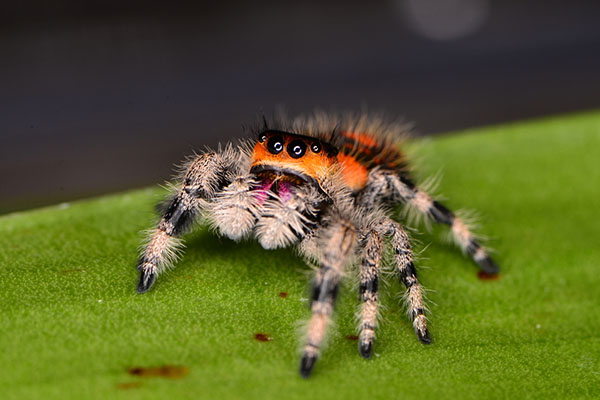What has eight legs, jumps and dances The fuzzy little jumping spider, of course.

GET TO KNOW AN ADORABLE ARACHNID: MEET THE JUMPING SPIDER
Spiders in general get a bad reputation. But the jumping spider (family Salticidae) is pretty darn cute. That’s right. We totally described a spider as being “cute.” In addition to being easy on the eyes, jumping spiders are pretty interesting creatures, too.
Ready to learn some fun facts about these adorable little arachnids? We’ve got plenty for you.
But First, Are Jumping Spiders Dangerous?
Let’s go ahead and address the elephant in the room. You’re wondering whether jumping spiders are poisonous. Technically, yes. Jumping spiders are venomous spiders. They use their venom to paralyze their prey.
However, you needn’t worry about being bitten by one. Jumping spiders are pretty shy and will usually run — or jump — away when humans approach. Additionally, their venom is not dangerous to people because they can't deliver a large enough dose of it to be harmful.
Now on to your jumping spider trivia!
Fun Fact No. 1: Jumping Spiders Really Jump

Away we go!
These little leapers earned their names. But they don’t just hop around because it’s fun. Jumping spiders use their legs to pounce on their prey, which is typically other insects.
Amazingly, jumping spiders don’t have special leg muscles, like grasshoppers, to help them leap. They propel themselves by suddenly changing the blood flow in their body. When a jumping spider wants to soar, it contracts special muscles to increase the flow of blood to its legs. This makes the legs fully extend and sends the spider flying — sometimes as far as 50 times the spider’s body length. Pretty cool, right?
Fun Fact No. 2: They're Excellent Dancers

Wave your legs in the air like you just don't care.
When male jumping spiders want to attract the attention of female jumping spiders, they do a little dance. The dance involves beating their abdomens on the ground and waving their legs in the air. The spiders also tap their feet on the ground so quickly that it can’t be seen by the human eye.
Those are just the simpler dances, though. The peacock spider ups the dance factor by also wooing potential mates with a brightly colored fan-like extension that he waves around as he stomps and taps.
Fun Fact No. 3: Jumping Spiders Have Great Vision

I see you.
Our fuzzy friend has some of the best vision in the spider world. Jumping spiders have four sets of eyes. There are two large eyes right in front, with a smaller eye on either side. Then, on the top of their heads, jumping spiders have two medium-sized eyes and two smaller eyes.
And those eight adorable eyeballs aren’t just for staring at you. Jumping spiders use their vision to hunt for insects to prey on. Additionally, the female jumping spiders use their peepers to judge the dance moves of the males.
Fun Fact No. 4: They Don't Hunt Using Webs

Who needs a web?
Unlike many spiders, the jumping spider doesn’t trap prey using a web. With its outstanding long-jump hunting abilities, why would it need to?
That doesn’t mean these furry cuties aren’t capable of making silk, though. Some jumping spiders will spin tiny tents or shelters to protect them from rain or nighttime predators. Additionally, whenever the spider takes a leap, it anchors itself using a string, just in case it misses its target.
Fun Fact No. 5: They Mimic Other Insects

Hiding in plain sight.
Myrmarachne melanocephala, also know as ant-mimicking spiders are a species of jumping spiders who are masters of disguise. These little leapers act like ants to fool predators and prey.
They’re longer than most jumping spiders, and have narrow false waists to make them appear more ant-like. These spiders will also take on the colors of different types of ants. In addition, they wave two of their legs around like antennae to better blend in. Pretty smart, huh?
Like we said, these fuzzy little guys are actually pretty cool once you get to know them. Many bugs are. So if you’re ready to leap into more interesting insect info, read up on the monarch butterfly and its amazing migration habits.
Sources:
• University of Michigan - BioKIDS
• Mother Nature Network
• About.com
• National Geographic
• Discover Magazine


